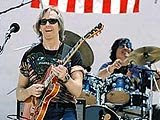
During the years I've played guitar in a Santana Tribute band, people generally assume that I'm a huge Carlos Santana fan. It's true that I've always enjoyed his music (especially the first two albums, Santana by Santana and Abraxas), but since I didn't really learn any Santana songs in depth until decades into my guitar career, he didn't exert a noticeable influence on my guitar style.
Actually, short-time Santana band member and co-guitarist Neal Schon (of Journey fame) played a much greater role in my development as a 6-string slinger, as I have long admired his melodic finesses combined with technical prowess.
But I have never been able to really learn someone's music in detail without coming to appreciate it on a deeper level, and such has been the case with Santana's music. As a guitar player, I certainly comp his lick's note-for-note during the tribute band gigs. And although his playing style is different from mine, his flair for stripping a guitar line down to its essence has definitely inspired me.
One of the the things Carlos excels at is playing melodies that are harmonically simple but rhythmically complex. He does it so naturally that it's not generally noticeable, but try to mimic his style and you'll find you really have to pay attention to your phrasing.
Additionally, I have taken a cue from the original Santana band, as a unit. Having always been a devotee of chordally complex music, I was delighted to study how Santana could take, not a 3-chord, not a 2-chord, but a 1-chord song ("Jingo"), and use a dynamic arrangement to keep it interesting. Awesome!
Even the most popular of Santana songs -- their re-make of Tito Puente's classic song "Oye Como Va" -- employs a simple 2-chord progression (i and iv) that never changes. Yet the arrangement is so interesting that the song never loses its trademark drive.
When writing the songs for my band Savor's CD, ¡Moviendote!, I tried to utilize those principles, as well as techniques gleaned from years of listening to and writing many different styles of music. Since the instrumentation is the same (guitar, bass, keyboards, drums, timbales, congas, hand percussion), it can't help but bear a common thread with Santana. But I see it as just one of the facets that make up a musical menage.

